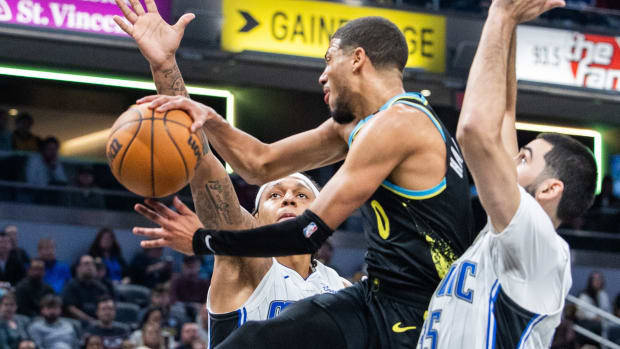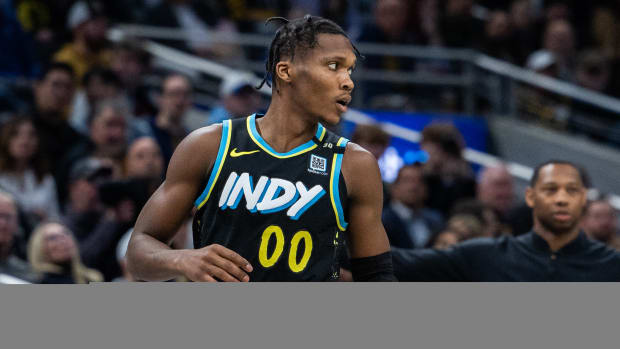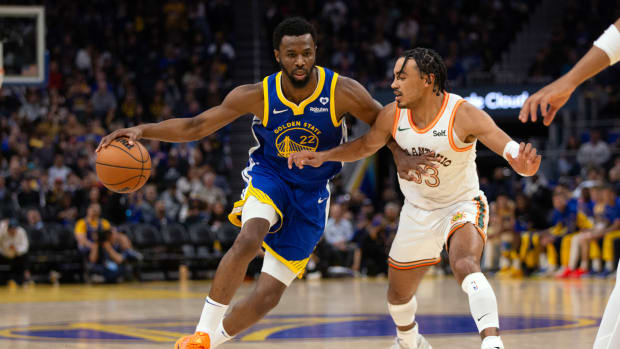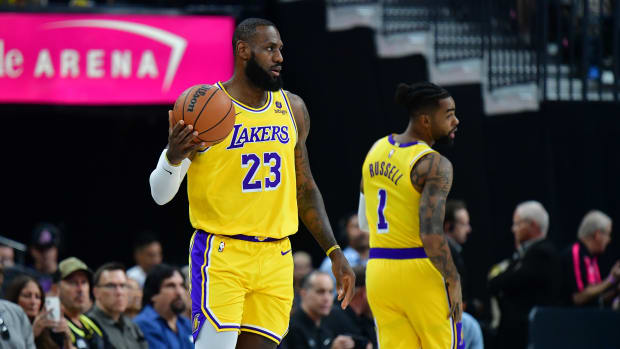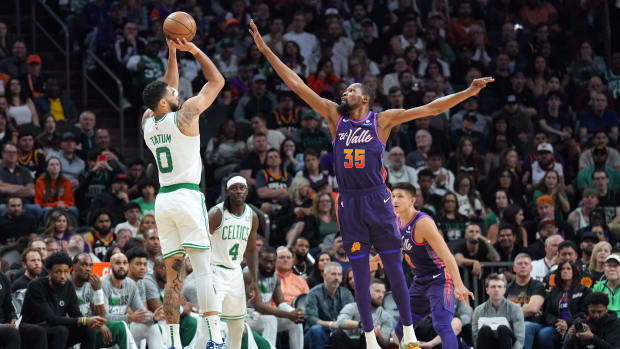Putting the NBA in Virtual Reality to the Test
When TNT color commentator Reggie Miller, seated courtside, donned a Virtual Reality headset while broadcasting a Warriors–Spurs playoff game this week, Basketball Twitter predictably lit up with questions and skepticism. “Isn’t the point of VR to have the feeling of being in the arena?” one viewer asked. Another opined: “Marveling at VR while *at the game* really rings hollow. There’s no way the VR can surpass the experience of actually being courtside.”
Miller’s stunt, of course, was blatant product placement. After all, the NBA, Turner Sports and Intel launched a new VR partnership earlier this season, airing seven games in VR during the regular season and at least 12 more during the playoffs. As the new technology has yet to achieve mainstream acceptance, using a Hall-of-Fame talent to market the gizmo in front of a large and captive national TV audience was a corporate suit’s dream scenario.
Underlying most of the online pushback was, frankly, a lack of knowledge. What does the NBA in VR even look like? How could it possibly be useful to a broadcaster like Miller? To explore those questions, I donned a headset and put the NBA in VR to the test during Cleveland’s Game 2 win over Indiana on Wednesday.
Here’s a full review of how it went from unboxing to the final buzzer. Note: Intel provided the phone and headset used for this product review.
Getting Started
For this product test, I used a Samsung Galaxy S7 phone ($469) and a Gear VR Oculus headset ($129) in conjunction with my cable TV subscription and 5G home Wi-Fi network. Much to my chagrin, the NBA in VR is not currently available for Apple iPhones.
Getting started involved four quick steps: 1) fully charging the phone, 2) connecting the phone to my Wi-Fi network, 3) downloading and installing the Oculus VR and NBA on TNT VR apps, and 4) opening the NBA on TNT VR app so that I could sign in with cable TV login information.
At that point, the phone prompted me to switch over to the headset, so I attached the Galaxy S7 to the Gear VR headset using the phone’s power slot. The phone snapped snugly into place. I adjusted the headset’s Velcro strap to fit my head, turned the top dial to sharpen the image, and used the phone’s side-button controls to turn up the volume.
Within minutes, I was ready to launch the app, which loaded in roughly 20 seconds. A straightforward content menu popped up, including an archived version of Golden State’s Game 2 win over San Antonio, a live broadcast of Cleveland’s Game 2 game against Indiana, archived content from All-Star Weekend, and a listing of future games that will be broadcast in VR. I found the app’s hands-free interface to be very intuitive: I directed a cursor with my eyes towards one of the options—the live broadcast—and the app loaded it in short order.
The Viewing Interface
As soon as the game started, it became clear that I was watching a full-on production rather than a sideshow. Think of the NBA in VR like TNT’s dorkier younger brother: There were TNT graphics and highlights, TNT-quality intro videos, and well-known TV commentators in Kevin Ray and Sarah Kustok. The centerpiece of the production was the VR Cast mode that featured a director controlling the action by alternating between camera angles and cueing up replays. Just like a traditional TV broadcast.
I was also able to select my own camera angle, choosing between Intel panoramic cameras stationed at courtside on the sideline, on each of the two basket stanchions, and on the suite level at the back of the lower bowl. The following video clip shows Minnesota’s Karl-Anthony Towns dunking from the basket stanchion angle.
Importantly, each of these camera angles—including the VR Cast mode—are active rather than static. In other words, I could look around the court with my eyes to control precisely what I was watching at any given moment. From the backboard stanchion camera, I could pan from the left corner all the way to the right corner at any given moment, regardless of where the ballhandler was located or what he was doing.
One nice touch for stat nerds and fantasy players: Box scores are built directly into the viewing experience. All I had to do was look to the far left or far right of the court to load up a list of points, rebounds and so forth. Similarly, looking up displayed a scoreboard with time remaining.
Prior to this product test, I had only limited experience with VR. My first impression of the NBA in VR was a bit jarring: The players looked like superhuman video game characters, the level of visual control was intimidating, and the action seemed faster than a typical NBA game.
My eyes and brain caught up within about 10 minutes, and the familiar TNT production value helped with the acclimation process. The commentary was a little sparser than a traditional TV broadcast, which allowed the arena noise and atmosphere to shine. The playoff intensity inside Cleveland’s Quicken Loans Arena was palpable: the screaming DJ, the anxious fans, and the nonstop music all filtered through the headset experience.
The NBA in VR wasn’t the same as real life, but it was remarkably life-like. Déjà vu hit hard once I cycled to the suite-level camera, as it was located extremely close to my media seat for last year’s NBA Finals.
The Gameplay Experience
As someone who watched hundreds of games this season, I enjoyed seeing the game from nontraditional angles and with such flexibility. The players were easily identifiable, and they were captured by cameras that seemed impossibly close to the court. My biggest gripe was that the video quality suffered from some pixilation; the crispness didn’t quite measure up to what I am accustomed from a high-definition television or in person.
But VR has its advantages. Most obviously, in the proximity of Intel's panoramic its cameras to key plays.
The sideline courtside angle delivered the most “Wow” moments. Watching transition play from end to end looked like the best video game ever come to life, and the raw speed of the NBA game came through even more powerfully in this format than on a traditional broadcast. When LeBron James darted into a passing lane for a steal and then took off for a transition dunk, my head rotated sharply to follow him, just as it would have if I was seated courtside in real life.
That was only the beginning. As Pacers coach Nate McMillan and one of his players argued a call near mid-court, the courtside angle tracked their discussion with the referee from mere feet away. I felt like part of the conversation, and McMillan’s angst jumped to life even more than it did during a close-up shot on the traditional broadcast. In that same vein, it was easy to feel the players’ emotions and fatigue as they walked past the courtside camera to return to their huddles during fourth-quarter timeouts.
One thing that I hadn’t anticipated: the courtside angle remained active throughout the pre-game festivities and during timeouts. Rather than sit through commercials, I used the courtside camera to watch the National Anthem, t-shirt tosses, team huddles, and a breakdance squad.
For a commentator like Miller or even a fan paying thousands of dollars to sit in the front row, the sideline courtside point of view is not always ideal for plays under the hoop.
Case in point: James drove hard down the middle of the key and took a flagrant foul from Domantas Sabonis. The VR’s stanchion camera captured the foul brilliantly, easily beating the sideline camera and comparing favorably with the multiple angles used on TNT’s traditional television broadcast. From the stanchion viewpoint, James moved directly towards me, and the foul felt like it was occurring at arm’s length.
And that’s where Reggie Miller’s skeptics might have missed the mark. If a commentator regularly needs a television monitor to deliver proper analysis in game situations, such as the James foul, turning to a VR headset to perform that task seems like it a natural evolution. Ditto for referees who currently use courtside television monitors to look at replay reviews.
The stanchion viewpoint was really a treat: The camera was set far enough back from the rim so that I didn’t flinch when players attacked the paint, yet it was still close enough to deliver a detailed look at the action. This angle was perfect for dunks and blocks above the rim. It was great for watching cutters knife through space, for high pick-and-roll chess matches, and for watching help defenders carefully cheat towards the ball side. It also came in handy during multiple video reviews.
Above all, the stanchion angle appeared to be perfectly suited to the NBA’s pace-and-space era. This angle excelled at showing how little daylight elite playmakers need to turn the corner and how much ground defensive players must cover against four-out and five-out offenses. Watching a few possessions from this angle quickly provoked two responses: 1) a newfound appreciation for All-Stars like James and Oladipo, and 2) a deep pity for their opponents.
Room for Improvement
Although this is the first season that the NBA, Turner and Intel have partnered to produce VR content, the product didn’t feel like it was in beta. The biggest issues—camera angles, production, graphics, broadcasting talent—were addressed. Nothing important was missing.
Still, there are limitations. In addition to the pixilation, I encountered a few technical issues. During the first half of Wednesday’s live broadcast, the video feed lagged badly enough that it was unwatchable for stretches. (There was no lagging during the second half of the live feed or when I watched archived clips.) On two occasions, the Galaxy S7 delivered an error message saying that it was overheating and needed a few minutes to cool down. Lastly, watching in VR really taxed the phone’s battery life. Viewing a full live game might require a halftime recharge.
The VR Cast mode—directed by the production staff—consistently delivered all aspects of the gameplay that mattered. However, there were blind spots when I selected my own specific angles. For example, the sideline courtside camera can’t quite see the near corners, and the stanchion cams are not ideal for watching the action on the opposite end of the court. On multiple occasions, I saw shots arc towards the hoop, but I couldn’t see who shot them.
Switching between the angles to chase a better view wasn’t an instantaneous process. As a result, I mostly stuck to the VR Cast mode so that I wouldn’t miss anything important, using the alternate angles only for a change-of-pace. Similarly, the fast-forward/rewind interface during archived games could be better. It was quite cumbersome to scroll through the three-hour tape to arrive at a certain spot in the game, although condensed highlight packages were available.
VR’s strength as an immersive experience came unfortunately required sacrificing real-time access to social media and my smartphone’s other functions. Indeed, watching in VR led to a serious case of FOMO. What are the beat reporters tweeting? Which memes are trending? What is bubbling in the group chat?
As a result, I regularly removed the headset during breaks in play to check in on my laptop. That process proved to be a little clunky, and it staggered the steady flow of the second-screen experience. Reading text messages required exiting the NBA In VR app or using a second phone. At the very least, a built-in Twitter stream to complement the box scores would be a welcome addition.
Final Thoughts
As a stand-alone proposition, the NBA in VR remains a tough sell. The cost of the VR headset ($129) I used for this review is more than half of an annual League Pass subscription ($199). From a cost-per-game perspective, buying the headset exclusively for the NBA in VR probably doesn’t pencil out for most people. Possible exceptions: Diehards who already own a compatible phone or who can’t attend games in person.
Of course, the NBA is just one of many entities pumping out VR content. With other live sporting events and video games available in VR, power users could find it easier to stomach the headset’s price tag.
The original skepticism over Reggie Miller having no use for a VR headset now seems slightly misguided. Wearing a headset for an entire game while seated courtside would be foolish, but the NBA in VR quickly delivered angles that would be useful and entertaining to commentators and fans alike.
It’s probably best to think of VR as a complement to the traditional broadcast, rather than as a true replacement. I enjoyed switching back and forth between the headset and the normal TV broadcast, and the VR experience was distinct and refined enough to make it more than a gimmick.
As a loyal iPhone user, I wouldn’t trade in my phone solely for the NBA in VR. The experience was awesome, but not phone-ditching awesome. Even so, I will watch again, and I can imagine situations—controversial calls, buzzer-beaters—where VR would be preferable to my own field of vision. Even if I was seated on the floor next to Miller.
































